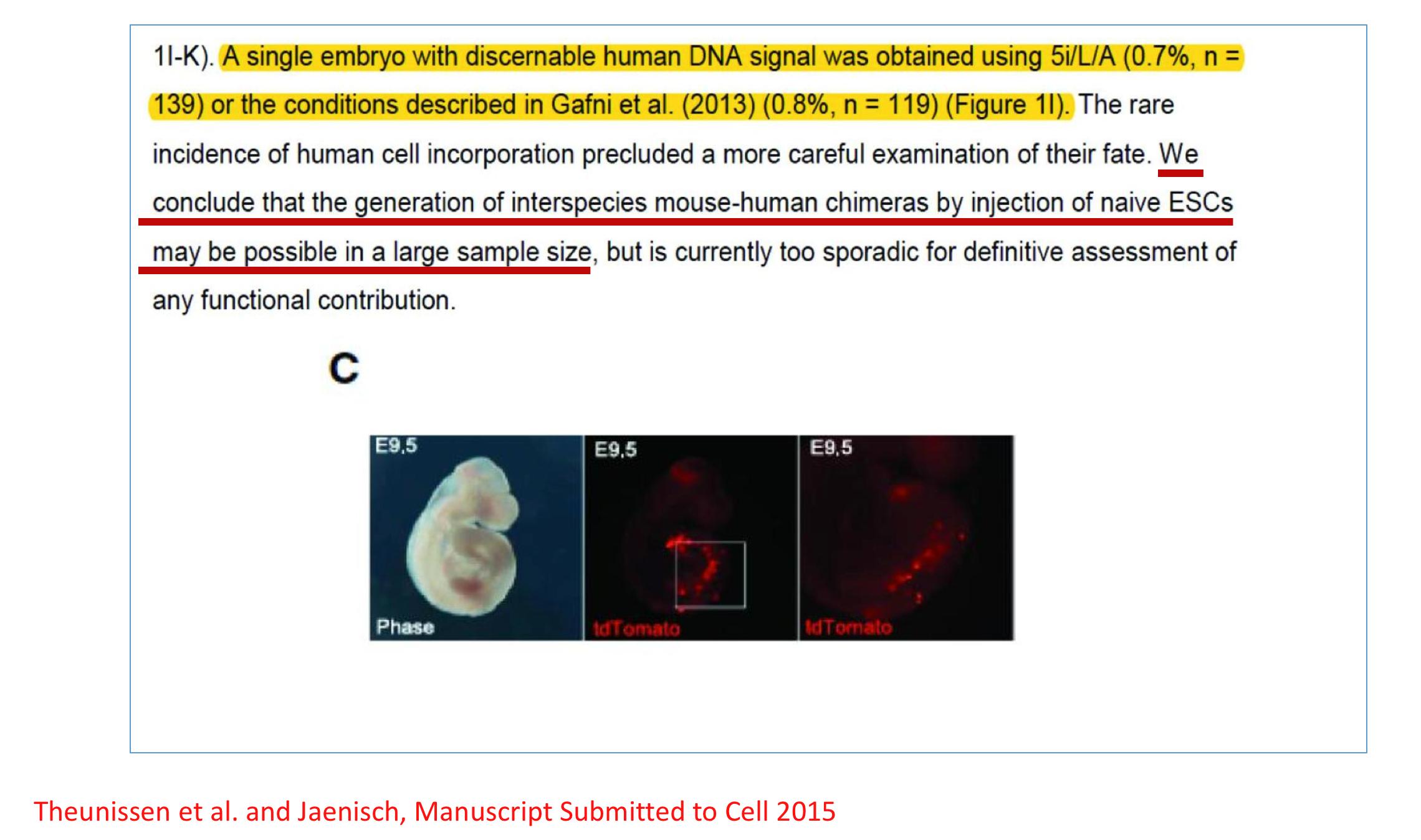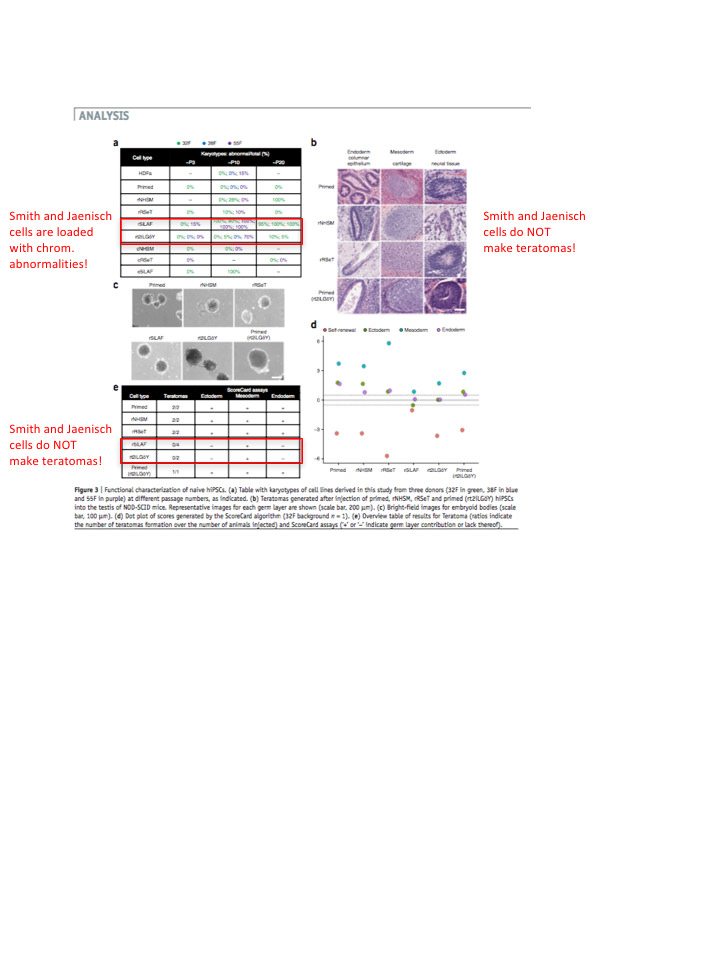pubmed: 25090446 doi: 10.1016/j.stem.2014.07.002 issn: 1875-9777 issn: 1934-5909
 ,
Benjamin E. Powell
,
Haoyi Wang
,
Maya Mitalipova
,
Dina A. Faddah
,
Jessica Reddy
,
Zi Peng Fan
,
Dorothea Maetzel
,
Kibibi Ganz
,
Linyu Shi
,
Tenzin Lungjangwa
,
Sumeth Imsoonthornruksa
,
Yonatan Stelzer
,
Sudharshan Rangarajan
,
Ana D'Alessio
,
Jianming Zhang
,
Qing Gao
,
Meelad M. Dawlaty
,
Richard A. Young
,
Nathanael S. Gray
, See more
,
Benjamin E. Powell
,
Haoyi Wang
,
Maya Mitalipova
,
Dina A. Faddah
,
Jessica Reddy
,
Zi Peng Fan
,
Dorothea Maetzel
,
Kibibi Ganz
,
Linyu Shi
,
Tenzin Lungjangwa
,
Sumeth Imsoonthornruksa
,
Yonatan Stelzer
,
Sudharshan Rangarajan
,
Ana D'Alessio
,
Jianming Zhang
,
Qing Gao
,
Meelad M. Dawlaty
,
Richard A. Young
,
Nathanael S. Gray
, See moreErratum 10 years ago -
Erratum 10 years ago -
1) http://www.cell.com/cell-stem-cell/abstract/S1934-5909%2814%2900394-4
2) http://www.cell.com/cell-stem-cell/abstract/S1934-5909%2814%2900340-3
possibly more to come ??
http://www.ncbi.nlm.nih.gov/pubmed/25215486
1) Tesar group has used their Enhancer mapping data, and showed that the naive patterns change they characterized in mice, are also evident with Gafni Naive vs primed chip-seq samples. (http://www.ncbi.nlm.nih.gov/pubmed/24905169)
2) A cool Nature paper from last month also validated naive features with a retroviral reporter,
and the Gafni conditions performed best, and also gene array data was very helpful and consistent. http://www.ncbi.nlm.nih.gov/pubmed/?term=naive-like+and+nature
3) The use of Gafni condition, including P38i and JNKi on Rhesus naive iPS cells, allowed the generation of primate-mouse chimeras, consistent with Gafni et al.
http://www.cell.com/cell-stem-cell/abstract/S1934-5909%2814%2900395-6
4) Seems like all ingredients used by Gafni, including PKCi, are used by Austin Smith work, so it cannot be that different after all!!.
2) A sensationalist paper that lacks a nuanced understanding of the mouse 2C paper, which is for elements that are normally silenced. The elements in this paper should already be part of the hESC network.
3) This paper was shown on PubPeer to have duplications, undermining the credibility of the study. The study while using JNK/p38i actually shows that PKCi and ROCKi cause differentiation. Further, a close look at the chimera efficiency shows about 1-2% formation efficiencies. This is far from a reliable or robust assay.
4) Austin Smith is very explicit about his opinion of the Gafni cells. He refers to the culture conditions as "incoherent," and considers the cells as a mixture of cells inhabiting different phases of primed pluripotency, which is consitent with the absence of naive pluripotency TF expression. Let's not be misleading about how Professor Austin Smith feels about this work.
It's clear that the Gafni cells are in a discrete state(s) of pluripotency, but there is disagreement about whether the cells can be considered "naive."
Reactivated X chromosome is one of the most important criteria for a naive state. Therefore the cell lines in this paper are not in a naive state.
We have independently confirmed their result. Analysis of their RRBS data confirms gradual decrease in DNA methylation.
We have independently confirmed their result. Analysis of their RRBS data confirms gradual decrease in DNA methylation."
Such sloppy science.
Did you see the number of caveats in the protocol?
I think that tells the entire story...
its more like a war rather doing science ... I think PubPeer just take the situation out to the surface
I think we need to wait and see which of these protocols will lead to something at the end... and for now I see that the Hanna's group succeeded together with Prof. Surrani to take it a step forward and convince others with their work...
and for those postdocs that are spending their time and efforts behind the flat scree just to attack others for being jealous .. use this time on the bench and animal house and defend your hypothesis and thoughts by real results...
thank you
1) http://www.ncbi.nlm.nih.gov/pubmed/25543152
2) http://www.ncbi.nlm.nih.gov/pubmed/23533168
3) http://www.ncbi.nlm.nih.gov/pubmed/25317556
and many more to come....
http://www.cell.com/cell/abstract/S0092-8674%2814%2901583-9
This is the first proof of concept and functional assay for the naive condition descried by Gafni et al.
Results, Results, and then Results, this is the language that scientists should speak.
http://www.cell.com/stem-cell-reports/abstract/S2213-6711%2815%2900002-8
2) A new paper just published in Cell Stem Cell shows that Hanna lab naive (NHSM) conditions allowed for the first time the generation of chimera competent monkey naive ESCs. This constitutes ultimate proof for true naive pluripotency in primates for the first time.
Cell Stem Cell 2015
Generation of Cynomolgus Monkey Chimeric Fetuses using Embryonic Stem Cells
http://www.cell.com/cell-stem-cell/abstract/S1934-5909%2815%2900264-7
----
Raises questions about "Naive" conditions by Jaenisch group ...
As you are posting personal emails, I think it would be appropriate to reveal your identity
https://pubpeer.com/topics/1/2B2B490DD36C55707411830470926D#fb26593
I'd be rather more worried about how a prestigious and leading edge journal like CSC deal with such cases.
These are more than four month old emails and was before all this "open discussion " started. I think Dr. Hanna was extremely honest about his science and contact other labs when he couldn't reproduce their results to get a clarification and ask for more detailed protocols. in other hand, other labs attacked Dr. Hanna papers without even contact him to get clarifications or ask for detailed protocol. I think it is simply because they were scooped even though there naive cells seems to be questionable.
This open discussion will helps the scientific community to realize the reality and make justice.
sincerely,
I assume that we are all scientists here, there should be a certain way that he resolve problems. I feel silly that I have to express this, but there should be a certain class with which we conduct ourselves. Our conflicts should be resolved with more sophistication that that which children use on the playground. The style of all these discussions regarding stem cells is appalling, what would the public think of us, were it to read these messages?
Now to the aforementioned emails. First and foremost, you do not expose private emails in public, thats a totally basic principle of communication. It does not matter how right you think you are, Peer1 has committed an infraction of basic communication amongst professionals. I almost hope that Peer1 is not Dr. Hanna, as it would sadden me that such a highly respected scientist stoops down to such a level. This brings me to my second point.
Maybe you genuinely do not understand this, but until you identify yourself nobody can really form an opinion based on the emails that you (shamefully) have posted here. As far as I know, you may or may not be Dr. Hanna himself and those emails may or may not be authentic.
In any case, you should lay off the computer and maybe sit in a room and think about what you have done. Either you are an impostor with fake emails, or you are Dr. Hanna with real emails. I do not even know which would be worse.
SPQR
What you basically say is that Edward Snowden couldn't reveal the NSA information without identify him self! And each journalist should reveal his resources. You again escape form-discussing science and what do you think about claiming generating new and novel stem cells state based on totally abnormal cells. This is a serious matter and stem cell society should be worry about how such work was published. In another hand, there is a medical promise behind naïve stem cells and there is a public interest on this. I think the most important point is to clarify that this is an artifact. I’d suggest you to test them by your self if you are stem cell scientist and report you finding with your identity.
I’m sure that the authors will not post any correction to the journal and they may not be affected because they are “strong” scientist, and they don’t make mistakes.
1- " what would the public think of us, were it to read these messages?" : You are against transparency. I think the public "who pay for the fund at the end" should be the first one to know about this scandale, and judge it by there self. you are encouraging rendering facts. ..Shame
2- Although I'm impressive by your essay writing ability, I didn't hear you scientific opinion on these "abnormal naive cells" and how you evaluate the scientific response of CSC and Prof, Jaenisch.
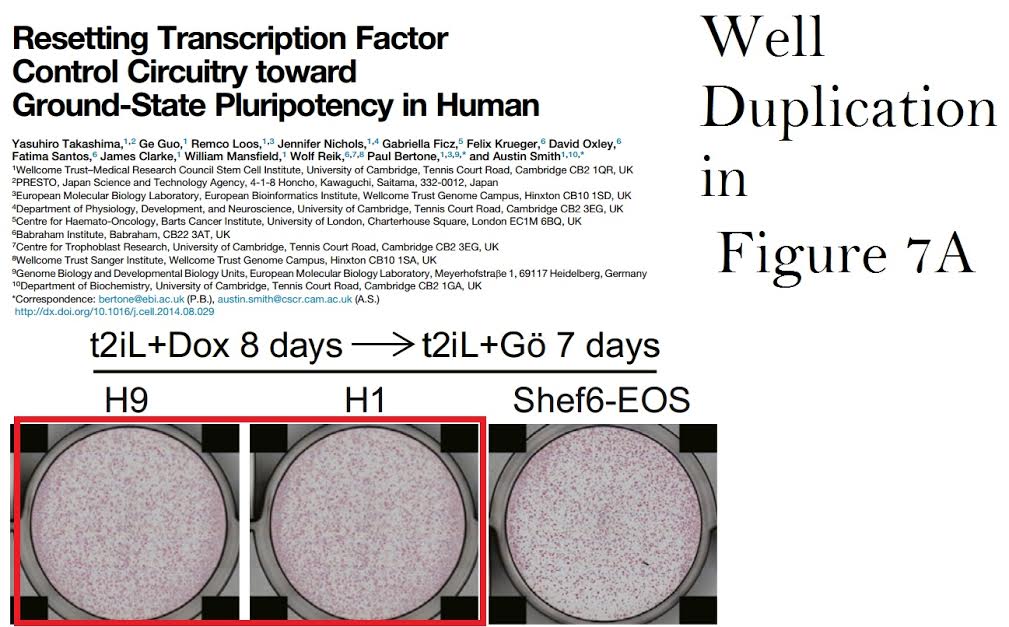
“Finally, duplications are evident in Takashima et al paper”
Please don’t deal in terminological inexactitudes. As you know since you have linked to the entirety of the evidence presented, a SINGLE duplication has been identified in one figure in that paper. One duplication in one figure of a paper is not to be correctly described as “duplications”. Not in the English language as she is spoke anyway.
Either you have a good argument to make without distorting the facts or you don’t. Get real man - everyone knows that science is self-correcting and that is why it is always best to be onside with the truth. Even if - sometimes - it is hard.

1) The cells are SSEA3-, chromosomally abnormal immediately upon generation, LACK EPIGENETIC IMPRINTING!!, inactivate X chromosome and apparently cannot differentiate either.
2) Delta-PE-OCT4-GFP cell line in the primed state was already chromosomally abnormal at the time of conducting the "unbiased screen", and is not GFP negative in the primed state, but rather has low signal. Both authors and journal editors ignore requests for rectifying this concern.
The plasmids to allow independent generation of such reporter lines are still suspiciously and selectively missing from Addgene for unexplained reasons ( https://www.addgene.org/browse/article/9219/ ) .
3) KLF2 is not expressed in human ICM (http://www.ncbi.nlm.nih.gov/pubmed/26293300)
Last page of this link is also relevant:
http://hannalabweb.weizmann.ac.il/wp-content/uploads/2015/08/Hanna-Lab-Detailed-and-Extended-WIS-NHSM-Formulations.pdf
#embryonal_carcinoma_stem_cells
http://www.sciencedirect.com/science/article/pii/S2213671116000564
http://bit.ly/29Tjk0v
Jacob H. Hanna2016 Jul 14 1:49 p.m. (9 hours ago)
Theunissen et al. Cell Stem Cell 2014 reported failure to detect human naive PSC derived cell integration in chimeric mouse embryos obtained following microinjection into mouse blastocysts, as was reported for the first time by our group (Gafni et al. Nature 2013). However, the authors failed to discuss that among different caveats, imaging and cell detection methods applied by Theunissen et al. Cell Stem Cell 2014 were (and still) not at par with those applied by Gafni et al. Nature 2013.
Regardless, we find it important to alert the authors and readers that Theunissen and Jaenisch have now revised (de facto, retracted) their previous negative results, and are able to detect naïve human PSC derived cells in mouse embryos at more than 0.5% of embryos obtained (Theunissen et al. Cell Stem Cell 2016) < http://www.cell.com/cell-stem-cell/fulltext/S1934-5909(16)30161-8 >. While the authors of the latter recent invest great effort to downplay the significance of their new findings and avoid conducting advanced imaging and/or histology sectioning on such obtained embryos, we find the 0.5% reported efficiency is remarkable considering that the 5i/LA naive human cells used lack epigenetic imprinting (due to aberrant loss of DNMT1 protein that is not seen in mouse naive ESCs!!
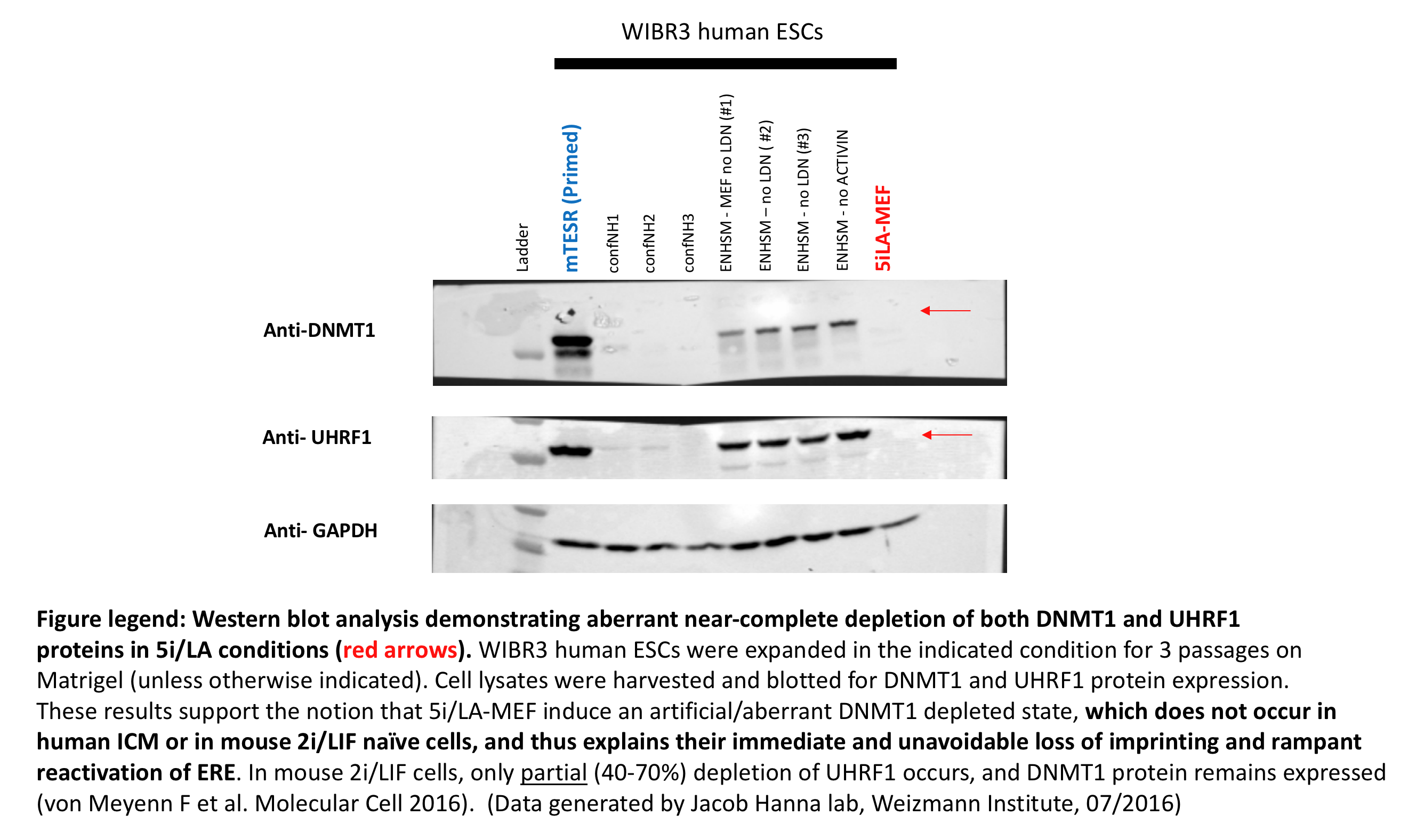 ) and are chromosomally abnormal. The latter features are well known inhibitors for chimera formation even when attempting to conduct same species chimera assay with mouse naive PSCs.
) and are chromosomally abnormal. The latter features are well known inhibitors for chimera formation even when attempting to conduct same species chimera assay with mouse naive PSCs.Finally, and less importantly, a copy of a previous version submitted and rejected by Cell journal earlier this year (kindly provided to us by a co-author), the authors present an exact same copy of their Figure 7, except that in the older rejected version also NHSM conditions yielded an embryo with detectable human cell integration. Despite of our open efforts, unfortunately the authors and the journal did not provide us with original raw data to exclude selective omission or biased manipulation of data <
 >. As such we question the integrity, objectivity and quality of the data being presented relating to this discussion by this group of authors.
>. As such we question the integrity, objectivity and quality of the data being presented relating to this discussion by this group of authors.1. The presence of GFP positive cells in a mouse embryo is not sensitive (one cannot see internal cells and is prone to auto-fluorescence artifacts. ). A case in point is the Gafni et al paper that reported 100% contribution of donor cells to embryos in Figure S10d - compare total identity of cells positive by GFP and celltracker, a 100% chimera??? The most likely interpretation: this is an auto-fluorescence artifact.
2. There is no contradiction between our 2014 and the 2016 paper regarding
chimera formation. In the 2014 paper we used only the presence or absence of GFP or Tomato as a criterion for the failure to detect chimeras. However, for the reason outlined above, this is not a strong negative result. That is why we developed the human mitochondrial DNA assay that allows detection of 1 human cell in 10,000 mouse cells. Using this assay, we saw .5% embryos, which had 1 to at most 5 human DNA cell equivalents per 10,000 mouse cells. We consider this a basically negative result as the DNA assay cannot detect intact cells (the human DNA could be due to lysed or dead cells). Thus, this assay represents a strong negative result (no human DNA excludes chimerism) but gives no information on whether the DNA positive embryos were indeed chimeras with functionally integrated human cells (we strongly doubt it). We clearly state in the paper: “The results summarized in Figure 7E failed to detect a significant difference between the various human donor cells in their low efficiency in colonizing mouse embryos. Moreover, it should be emphasized that the PCR assay can only detect the presence of human DNA but is not suitable to ascertain survival of human cells in the embryo, as the human DNA could be derived from lysed or dead cells”.
3. It is quite surprising that Hanna questions the integrity of our lab: he, who had to correct and retract papers because of numerous errors in data reporting, misrepresentation of data, and image duplication. Also, it would be informative to learn how he obtained access to an unpublished and confidential document (our Cell submission last year). During revisions for CSC we checked all data again and discovered that the single positive NHSM embryo was actually injected with 5i cells. The series of injections giving rise to this embryo is not part of the published table.
Thor Theunissen and Rudolf Jaenisch
1) GFP flourescence and your PCR assay were both recently used by your group in Cohen et al. PNAS 2016 to claim chimerism with human neural crest cells in mouse embryos ( http://www.ncbi.nlm.nih.gov/pubmed/26811475). You should be ashamed of this kind of hypocricy. Auto-fluorescence and dead cell derived DNA did not lead you to dismiss your published positive conclusions in your recent PNAS study.
2) You seem to be obsessed with speculations of auto-flourescence and other things, while the Hanna group has released multiple examples of specific detection of human cells in mouse embryos with convincing chimerisim (which you have attended during the NIH symposium). 0.5-2% efficiency should enable you to conduct tissue-sectioning on the embryos you are now obtaining. Yet again, you are frightened with results that might show that you were wrong, so you prefer spreading doubts, ignoring your new results and avoid conducting the simple follow-up tests.
http://osp.od.nih.gov/office-biotechnology-activities/event/2015-11-06-133000-2015-11-06-220000/workshop-research-animals-containing-human-cells
examples:
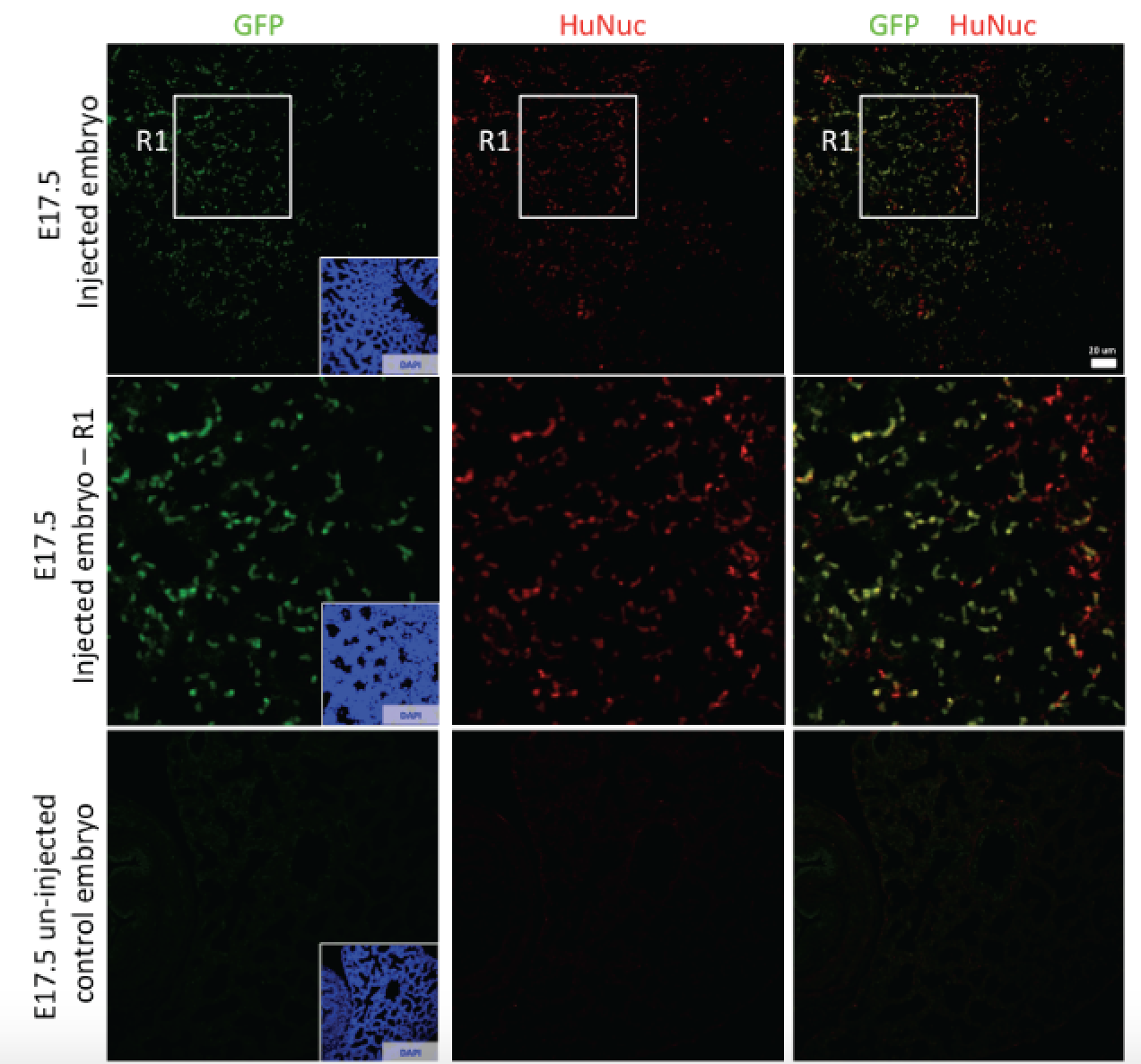



http://hannalabweb.weizmann.ac.il/wp-content/uploads/2015/08/Hanna-Lab-Detailed-and-Extended-WIS-NHSM-Formulations.pdf
3) Your explanation to the discrepancies in your injection tables is not satisfactory " The series of injections giving rise to this embryo is not part of the published tables" .. this is also not consistent with the fact that the injected number of embryos is identical between the two tables. What a Coincidence!! (
 )
)P.S. It is great you have more unpublished chimeric mouse embryos in 5i conditions, proving again that you were wrong in your 2014 paper regarding inability to detect any fluorescent+ human cells in all the conditions tested. You should retract that part of your 2014 CSC paper.
It appears now that not only your manuscripts flip-flop between submission to Cell and CSC, but also your formal public "explanations" keep evolving and are entirely different.
According to this public Tweet by Dr. Hanna < https://twitter.com/jacob_hanna/status/754037438390079488 > the explanation you have officially provided to him and Cell Stem Cell editor is completely different to the one your provide above.
Version 1 to Cell Stem Cell Editors and Dr Hanna: you claim that for your own reasons you had to run samples again, used an improved assay and then the initially positive NHSM embryo sample was no longer providing a reproducible positive signal, thus you adjusted your Table.
Version 2 you provide now on Pubpeer: you provide a completely different excuse: "During revisions for CSC we checked all data again and discovered that the single positive NHSM embryo was actually injected with 5i cells. The series of injections giving rise to this embryo is not part of the published table. "
I fail to reconcile your two excuses. I find this quite unbelievable and saddening.
P.S. I made a copy of relevant responses on imgur to make sure they do not get deleted.
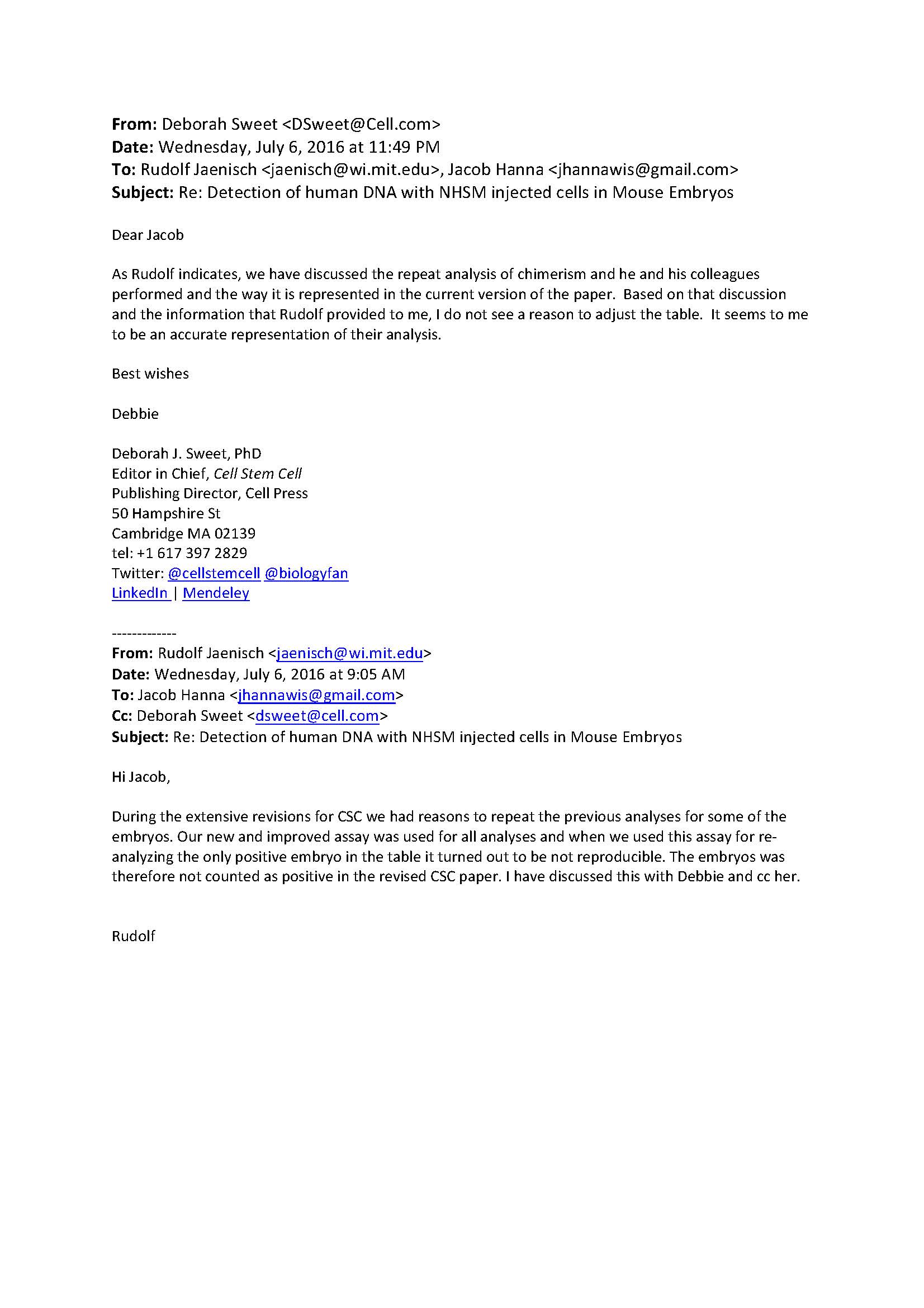


"We conclude that the generation of interspecies mouse-human chimeras by injection of naive ESCs may be possible in a large sample size, but is currently too sporadic for definitive assessment of any functional contribution."
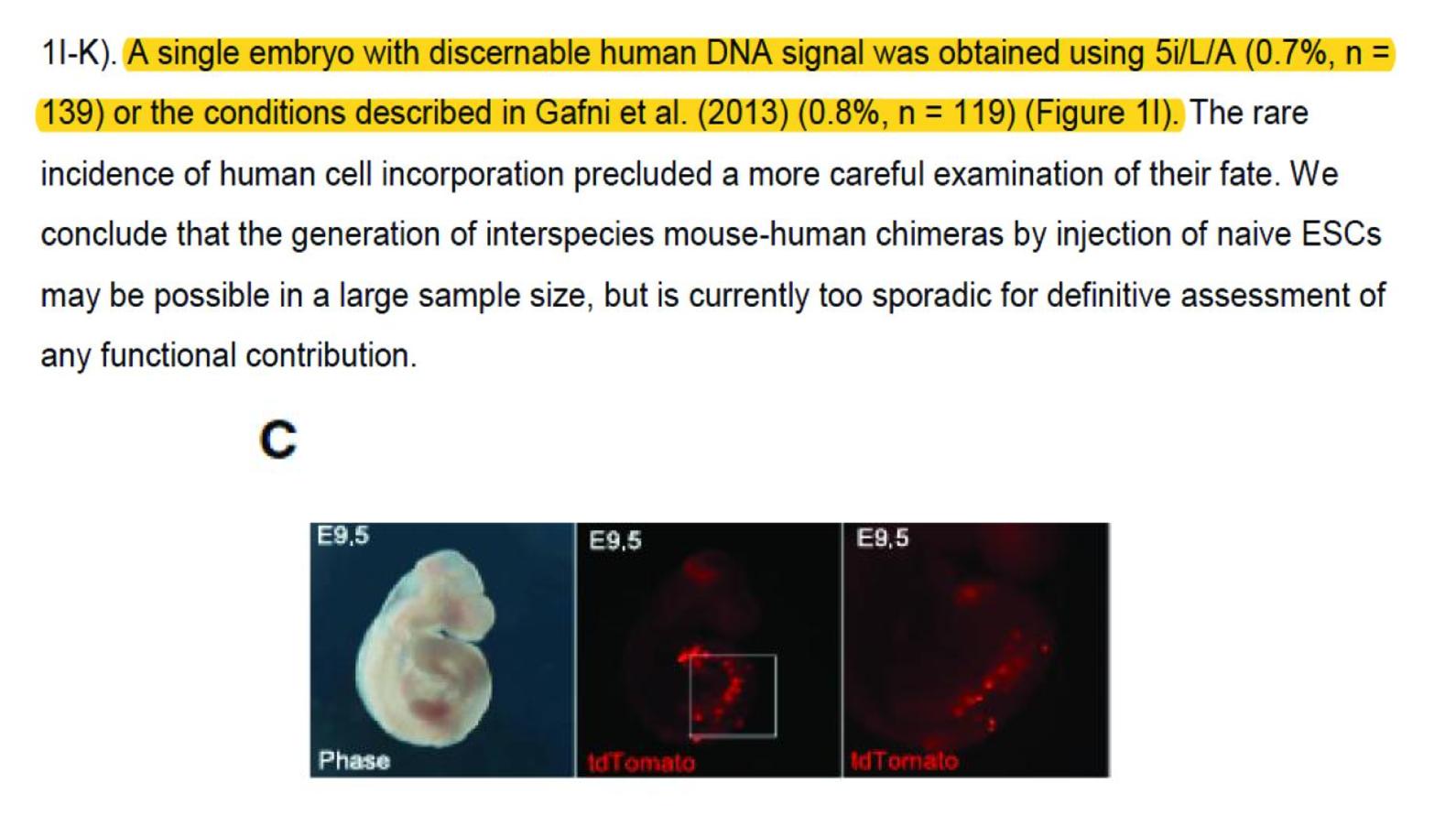
This is not accurate, fluorescent cells can be detected in mouse embryo, especially at early developmental stages.
There is a plethora of papers and transgenic mice models that detect fluorescent cells inside the embryo even in small numbers. Auto-fluorescence can be easily excluded by shifting to other filter set. Staining for HuNu and anti-GFP is only one way to exclude such artifact.
2- Did the authors analyzed earlier developmental stages? In order to exclude integration in other conditions, an earlier developmental stages should be analyzed before jumping to conclusions.
Rudolf Jaenisch should take a look at his own recent track record in regards to mistakes, irregularities and corrections. Only since 2011 he has published (a) 4 corrections involving Lack of disclosure of conflict of interest by him directly (and not his co-authros) and (b) 10 corrections, two of which are major corrections related to this highly controversial Theunissen et al. Cell Stem Cell 2014.
1) http://www.nature.com/ncomms/2015/150730/ncomms9008/full/ncomms9008.html
2) http://www.nature.com/ni/journal/v16/n8/full/ni0815-889a.html
3) http://www.sciencedirect.com/science/article/pii/S1934590914003944
4) http://www.sciencedirect.com/science/article/pii/S1934590914003403
5) http://www.sciencedirect.com/science/article/pii/S2213671114002008
6) http://www.sciencedirect.com/science/article/pii/S0092867413015341
7) http://www.sciencedirect.com/science/article/pii/S1097276513002153
8) http://www.sciencedirect.com/science/article/pii/S009286741100849X
9) http://www.nature.com/nature/journal/v531/n7594/full/nature16470.html
10) http://www.nature.com/nature/journal/v531/n7594/full/nature16479.html
Regarding Theunissen, briefly he is one of the master players in the Nanog gateway debacle from the house of Smith/Silva in the UK.
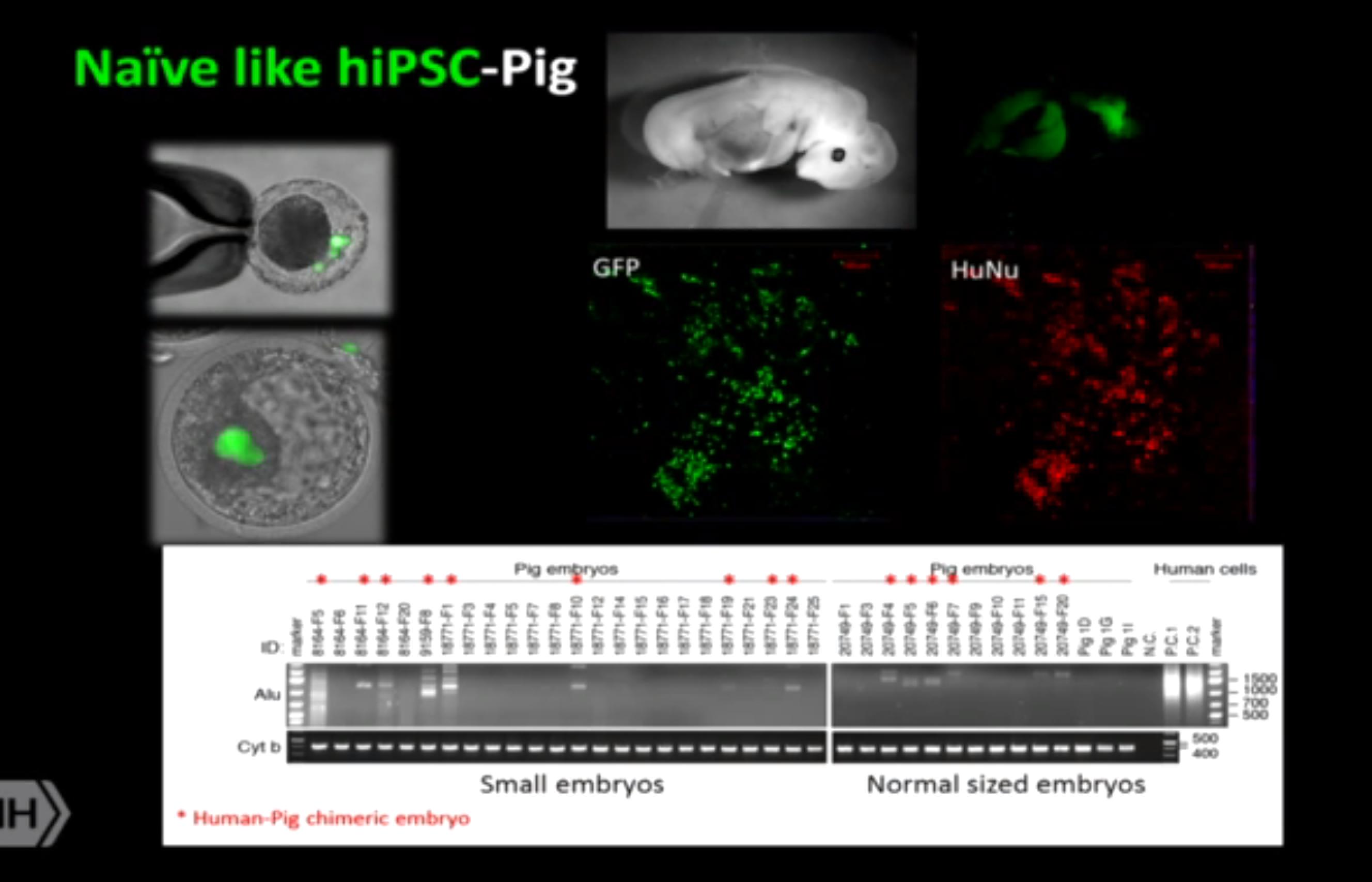

The video for NIH workshop held November 2015, in which these slides were presented, is available for viewing: http://videocast.nih.gov/summary.asp?Live=17471"
http://www.cell.com/cell/fulltext/S0092-8674(16)31752-4
A new independent study shows that the cells expanded in conditions described in this study acquire chromosomal abnormalities with 100% frequence by passage 10, and cannot differentiate in vitro or in vivo ( Figure 3 says it all).
https://www.nature.com/nmeth/journal/v14/n11/full/nmeth.4436.html
It is unclear which results were obtained with 5i, versus which results were obtained with 6i.
Does JNKi do anything?
Attach files by dragging & dropping,
selecting them, or pasting
from the clipboard.
![]() Uploading your files…
We don’t support that file type.
with
a PNG, GIF, or JPG.
Yowza, that’s a big file.
with
a file smaller than 1MB.
This file is empty.
with
a file that’s not empty.
Something went really wrong, and we can’t process that file.
Uploading your files…
We don’t support that file type.
with
a PNG, GIF, or JPG.
Yowza, that’s a big file.
with
a file smaller than 1MB.
This file is empty.
with
a file that’s not empty.
Something went really wrong, and we can’t process that file.
